2022: A Clear Way Forward
2022: A Clear Way Forward
It's a blessing that good can come out of such a challenging time – and being a part of assisting the blossoming of more resilient eco-systems in our client's yards. Surprisingly, the challenges of the past two years' pandemic have been a real boon for creating habitats and natural plant communities in the region.
We are constantly inspired by the resilience of our world which links humans, plants, birds, insects and other critters. Making home landscapes even more eco-functional by managing rain water and planting natives that provide nectar for pollinators and insects for birds, has been very gratifying.
The Spirited Gardener is growing and has welcomed Scott Morgan to our team. He joined us at the end of 2020 and helped contribute to our busiest year yet. Scott is originally from Adelaide, South Australia, where he obtained qualifications in both horticulture and permaculture. In addition, he recently participated in the National Green Infrastructure Certificate Program. He now lives in Evanston, with his two young boys.

Julia and Scott enjoy a short lunch break during their busy season.
Julia also joined the board of the Evanston Environmental Association (EEA) in 2020. The EEA helps support the Evanston Ecology Center and has begun an Annual Bird Buzz Native Plant Sale to further assist the re-wilding of our suburban and urban landscapes.
Get to Know Your Plants
or...
"Who stays and who goes?"
or...
"Who stays and who goes?"
All gardens in our city landscapes have a history of disturbance. We are connected to the broader eco-system and that means seeds will be introduced whether we want them or not. Sometimes it's a delight, other times not. When invasive* weeds find their way into our garden it's helpful to catch them early before they spread.
*Invasive species can lead to the extinction of native plants and animals, destroy biodiversity, and permanently alter habitats. They are: 1) non-native (or alien) to the ecosystem under consideration and, 2) likely to cause economic or environmental harm or harm to human health. - Definition is from the USDA National Invasive speciesInformation Center - https://www.invasivespeciesinfo.gov/what-are-invasive-species
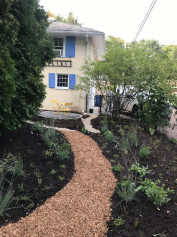
After establishing a native rain garden in this Evanston back yard garden in 2020, we learned there were some dormant weed seeds waiting to come up the following spring. Part of the plan, moving forward, is to steward this garden space towards a balanced species mix that provides the best habitat for humans and wildlife, while supporting the most pollinators we can. And that means identifying and removing weeds. Like these...
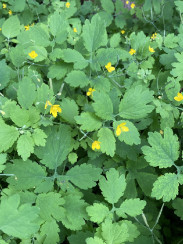
Chelidonium majus - Greater Celandine is an example of an invasive that is similar in appearance to our native Celandine Poppy. If not managed early (especially before it goes to seed!) it can spread and crowd out some of the plants we wish to encourage.
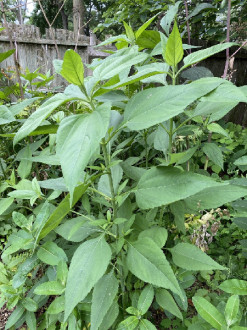
One of the plants that volunteered in this garden was Helianthus tuberosus, a regional native. Cultivated as Sunchokes for eating, they were no longer being harvested and started to spread too enthusiastically along the fence line. The client preferred their removal. This isn't always a problem if you choose to intentionally cultivate and harvest the bulbs to eat. But it is a plant that needs managing.
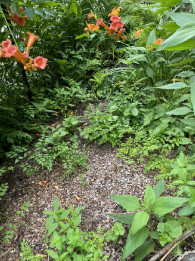
Campsis radicans, known popularly as Trumpet Vine, is another plant that deserves our attention. It's easier to manage in drier climates, but in Chicago gardens can start to wander rapidly via underground runners and, if not regularly pruned and contained by a root barrier, can make lots of trouble. It is also a great hummingbird magnet. A word of caution: Trumpet Vine is a notorious wanderer and it could turn up in your neighbor's garden uninvited.
Removing Invasives from the Landscape
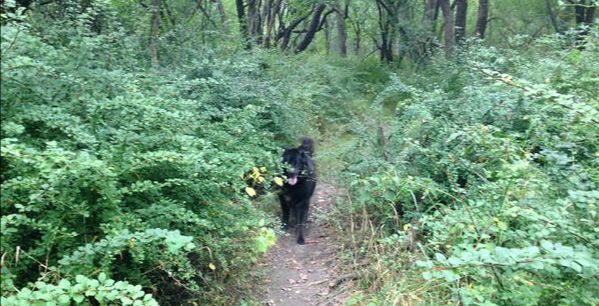 Barberry in Schiller Woods
Barberry in Schiller Woods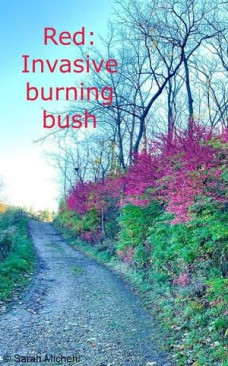 Clients of the Spirited Gardener have been making a difference by removing invasive Buckthorn, Tree of Heaven (which is a host plant to the invasive Spotted Lantern Fly, that has a growing population on the east coast and is threatening to spread to our region), and Barberry (above) from their properties. More people are acknowledging that Burning Bush and Callery Pear, though still available for purchase on the market here in Illinois, also need to be removed from our landscapes because of their invasive qualities. Eliminating these shrubs and trees is vital to the success of re-wilding our own native landscapes for the greater health of ecosystems' bird, bee and butterfly populations.
Clients of the Spirited Gardener have been making a difference by removing invasive Buckthorn, Tree of Heaven (which is a host plant to the invasive Spotted Lantern Fly, that has a growing population on the east coast and is threatening to spread to our region), and Barberry (above) from their properties. More people are acknowledging that Burning Bush and Callery Pear, though still available for purchase on the market here in Illinois, also need to be removed from our landscapes because of their invasive qualities. Eliminating these shrubs and trees is vital to the success of re-wilding our own native landscapes for the greater health of ecosystems' bird, bee and butterfly populations.A Beautiful Tribute in Chicago

We assisted in overhauling this backyard garden space to become a tribute garden for the client's late husband. We built and installed a large raised bed for edible plantings. Permeable brick pavers replaced the concrete to keep water where it lands and help it infiltrate. There is also a swale along the south fence line to direct water away from the building and into the garden.
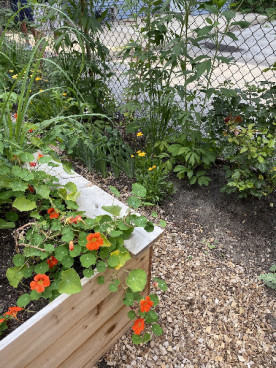
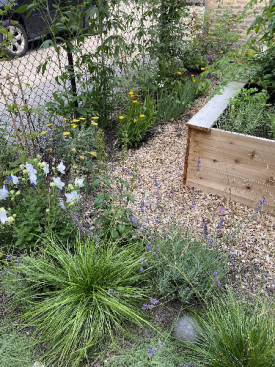
We found the Nasturtiums overflowing and plantings thriving when we visited later in the season.
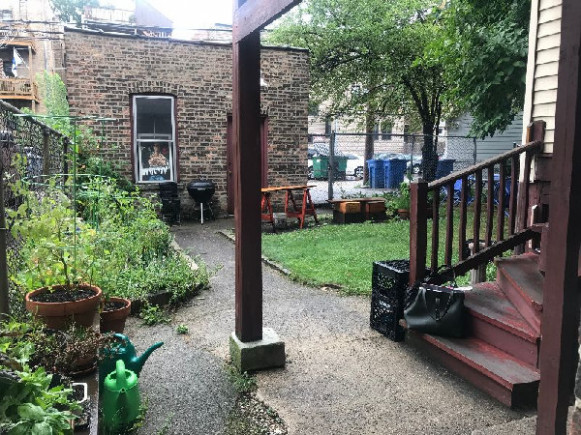 This "before" photo shows the lawn and concrete that were replaced by permeable surfaces.
This "before" photo shows the lawn and concrete that were replaced by permeable surfaces.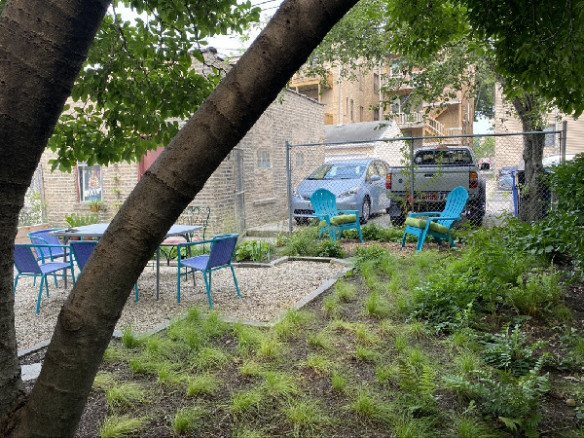 (Above) The Carex rosea, rosey sedge and ferns were thriving when we revisited later in the season.
(Above) The Carex rosea, rosey sedge and ferns were thriving when we revisited later in the season.(Below) Although the large Magnolia in the backyard is not native, it was a delight to work under its blossoms which, this past spring, lasted an unseasonably long time. We increased the number of natives on the property by at least 50% to nudge the garden closer to the preferred minimum of 70% to support our native birds, bugs, butterflies and bees.

Managing Rain Water for Our Environmental Health & Reducing Pressure on our Public Storm Water Systems
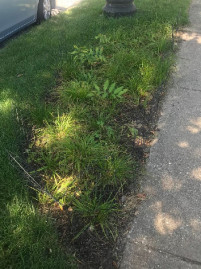
Our mission remains dedicated to the value of being a good neighbor. One simple action to take: Fix sidewalk flooding issues with a simple crescent rain swale (left), like the one we built outside my home. This beautifully re-routes storm water that would otherwise pool and freeze on the sidewalk. Viola! Safer winter walking conditions.
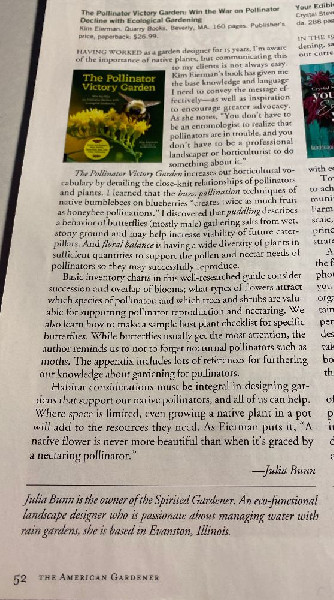 While attending an Ecological Landscaping Association event in 2019, Julia met the author of The Pollinator Victory Garden, Kim Eierman. In 2020, Julia was invited to review the book for the magazine of the American Horticultural Society, The American Gardener (pictured above). The experience solidified her resolve to become a stronger ambassador for the natural world in the gardens she designs in collaboration with her clients. We stock the books in our office to share with enthusiastic gardeners!
While attending an Ecological Landscaping Association event in 2019, Julia met the author of The Pollinator Victory Garden, Kim Eierman. In 2020, Julia was invited to review the book for the magazine of the American Horticultural Society, The American Gardener (pictured above). The experience solidified her resolve to become a stronger ambassador for the natural world in the gardens she designs in collaboration with her clients. We stock the books in our office to share with enthusiastic gardeners!DO YOU KNOW ANYONE WHO WOULD LIKE TO JOIN OUR TEAM?
We are looking for an office manager who wants to learn more about Native plant Landscaping & Ecofunctional Rain Gardens and is also interested in outdoor, physical work. There will be lots of learning opportunities. Our team has a positive work environment & a good hourly wage. Please contact or refer them to Julia at Spirited Gardener's email address: spiritedinfo1@gmail.com.
We will additionally be looking for extra help planting gardens and providing ongoing stewardship during the season. There is an opportunity for the right person to grow with our company.




